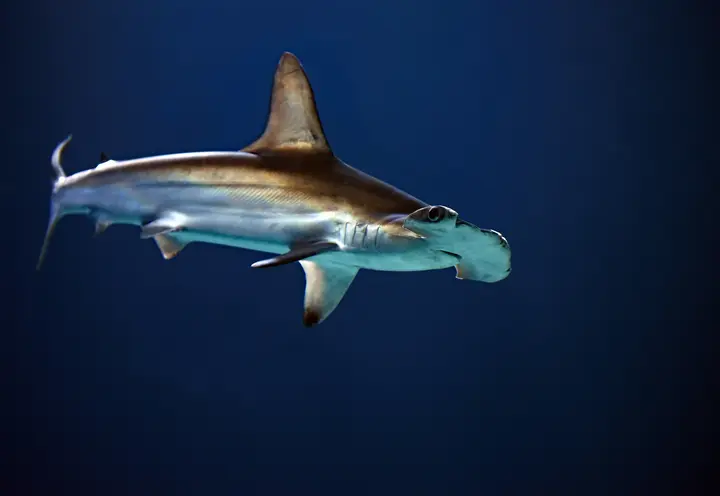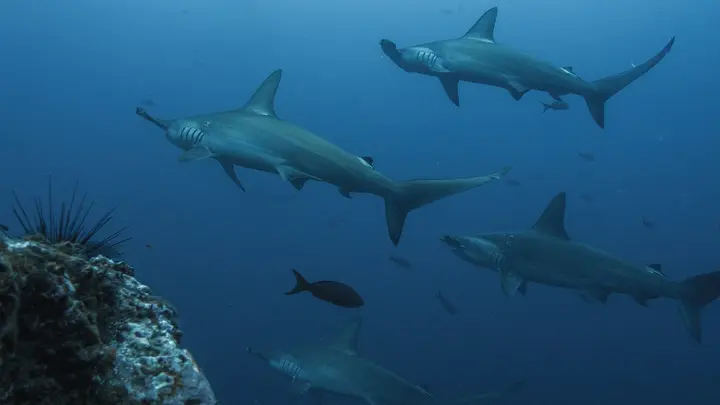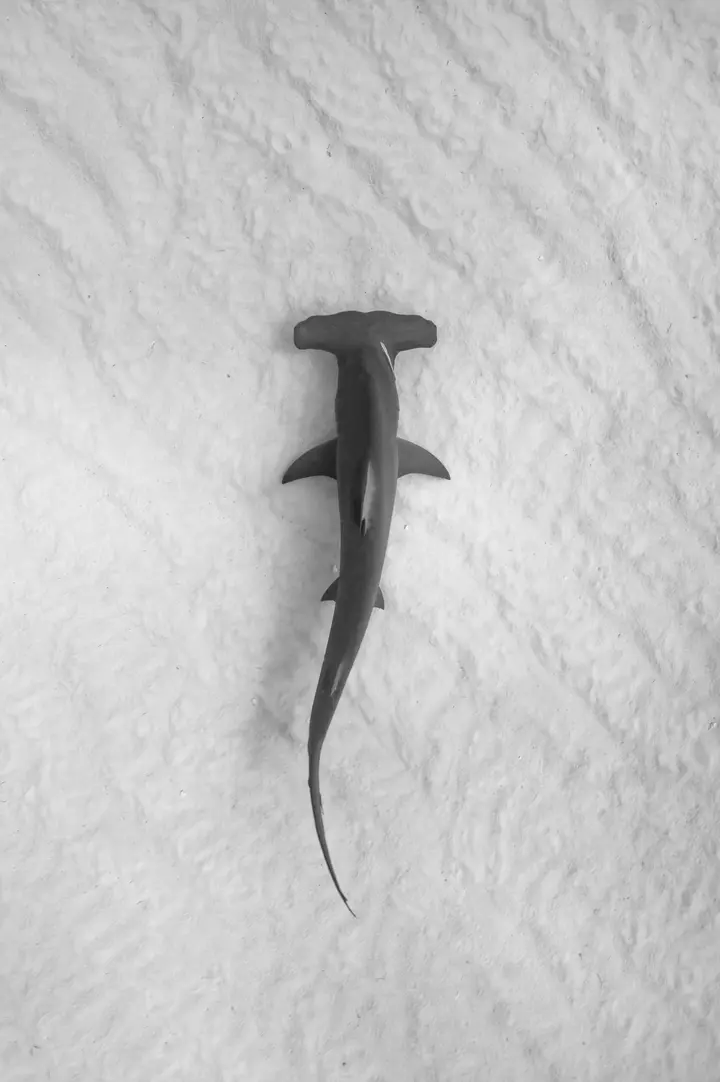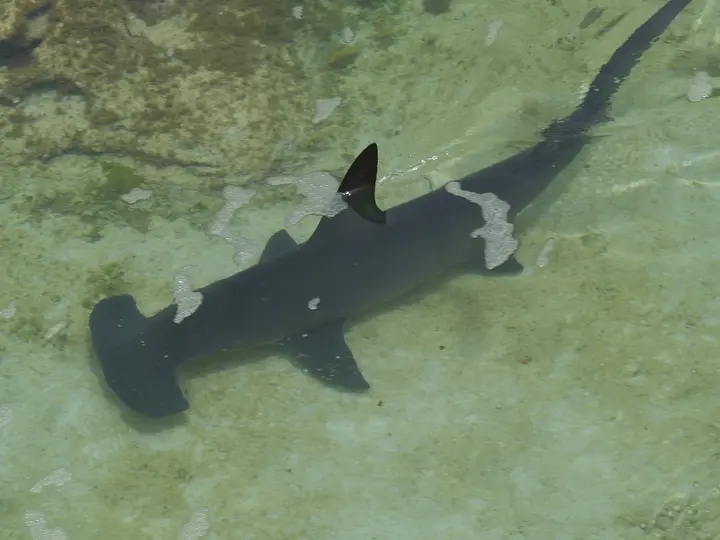Amazing Facts: Hammerhead Shark Secrets Uncovered

The hammerhead shark is considered one of the most impressive and exciting marine creatures. It is characterized by its unique shape that resembles a construction tool known as a hammer, which makes it the focus of attention of many researchers and those interested in marine life. The beauty of these animals lies in their amazing secrets, which they expose to reveal in this article. Let's review the surprising facts about the hammerhead shark and discover some of the secrets that surround it.
Show key points
- The hammerhead shark, with its distinctive hammer-shaped head, has fascinated scientists and marine enthusiasts since its discovery in the 19th century in major oceans around the world.
- Its uniquely shaped head enhances sensory perception, providing a wide field of vision and enabling precise detection of prey and underwater vibrations.
- The hammerhead is an exceptional and efficient predator, using its powerful head to strike and immobilize prey during hunting.
- ADVERTISEMENT
- Unlike many other shark species, hammerhead sharks display complex social behaviors and often live in organized groups or "swarms" that communicate using body movements, touch, and distinct clicking sounds.
- Despite their resilience, hammerhead sharks face numerous threats such as overfishing, habitat destruction, vessel collisions, and exploitation by sport hunters.
- Conservation efforts and environmental awareness are crucial for protecting hammerhead sharks and maintaining ecological balance in marine habitats.
- Ongoing scientific exploration and technological advancements continue to unveil surprising facts about hammerhead sharks, deepening our appreciation for their role in the ocean ecosystem.
1. The history of the discovery of the hammerhead shark

The discovery of the hammerhead shark dates back to the nineteenth century, when the first reports of its presence in the Pacific, Indian and Atlantic Oceans were observed. Through scientific expeditions and ongoing explorations, multiple new species of hammerhead shark have been discovered in various marine areas around the world.
Recommend
These fish may have lived in the seas and oceans for millions of years, but they were not widely known until modern times. Scientific research and deep-sea diving missions are the main reason for the discovery of the hammerhead shark and the identification of its different species and geographical distribution.
One of the main reasons researchers have increased the interest in these fish is their film and television depictions, which have attracted public attention. Since then, interest has increased in studying their striking traits and unique behavior.
So, the hammerhead shark is arguably a historic discovery in the world of the seas and oceans, and with the development of technology and increasing environmental awareness, there are still a lot of exciting secrets that need to be revealed about this wonderful creature.
2. Form the characteristic head shape of the shark

The head shape of the hammerhead shark is one of the most prominent features that distinguish it from other marine species. Its head has a distinctive hammer-like shape, with the middle part of the head holding the eyes and nose extending between the two. This morphology gives the hammerhead shark many advantages and has surprising explanations.
One possible explanation for the distinctive head shape is that it helps the shark improve its sensory abilities. The eyes on the median part of the head give him wide vision and enable him to accurately hunt his prey. In addition, the shape of the head enhances the shark's ability to sense sounds, as the ears are located in the middle part of the vertical hammer and are able to receive vibrations and sounds in the water.
These distinctive structures are also a way to maximize the shark's ability to navigate and control its movement. The researchers hypothesize that the distinctive head shape also acts as a natural stability for the shark, reducing resistance in the water and enabling the shark to maintain its balance during its rapid movement.
But the real reason for the formation of this unique head shape remains a mystery, and more research is needed to understand it more deeply. Whatever the reasons, the hammerhead shape of the hammerhead is an amazing evolutionary genius that captures the greatness of marine life.
3. The hammerhead shark used its hammer in hunting

The hammerhead shark is one of the unique features that distinguish this magnificent marine creature. This stunning shape hammer enables the shark to execute an elaborate and effective ocean fishing strategy. The shark has precise control over its flat, wide hammer, enhancing its ability to catch fish furs and other marine creatures.
With its powerful hammer, the hammerhead shark uses a unique technique in the hunting process. He uses hammer to deliver a powerful blow at his potential prey, helping him to incapacitate or kill it instantly. The hammerhead's distinctive head shape allows it to locate prey within the expanded field of view provided by the hammer's rounded shape, enhancing the accuracy and speed of attack.
This exceptional use of the hammer in the process of fishing is one of the most prominent natural creations. The hammerhead shark's ability to use its hammer as a unique fishing tool contributes to its survival as one of the sovereign ladies of the Ocean Kingdom, and is one of the surprising facts that amazes us at the intelligence and adaptation of this enchanting marine creature.
4. Social aspects and interpersonal communication in the hammerhead shark group

The hammerhead shark has a unique social system that distinguishes it from other marine creatures. These fiercest marine species live in groups called "swarms", which contain a number of male and female individuals. The hammerhead shark develops strong social relationships within the group and communicates with its members constantly.
Communication between members of the hammerhead shark group depends on several ways. These sea creatures use bodily movements and postures to communicate with each other. For example, a shark expresses interactive behavior and emotions through the movement of its distinctive hammer. The shark also uses touch and friction between group members to strengthen social bonds.
In addition, the hammerhead shark makes specific sounds when communicating with other individuals. The shark produces a click-like sound by hitting its hammer on different objects, which is an effective way to communicate and transmit information between individuals.
Scientists believe that social communication in the hammerhead shark group helps promote cooperation between individuals and establish solid social structures. This communication also helps boost hunting and survival opportunities.
The unique social and communication aspects of the hammerhead shark group enhance the charm of these marine creatures and contribute to our understanding of the nature of marine life.

The hammerhead shark faces significant threats that threaten to wipe out this unique marine creature. The survival of these animals depends on the fight against these threats and the adoption of sustainable protection and environmental measures. Here are some of the threats facing the hammerhead shark and future protection prospects:
1) Overfishing: Fishing for marine sharks for fins or for commercial purposes is one of the most prominent threats facing hammerhead sharks. Shark fishing causes a large number of these precious creatures to be wasted and has a negative impact on the balance of the marine environment.
2) Natural habitat degradation: The natural habitat of the hammerhead shark, coral reefs and coastal areas, is being degraded due to pollution and climate change. These adverse environmental conditions affect sharks' ability to survive and reproduce.
3) Collision with ships: The hammerhead shark faces the risk of collision with ships, which can cause fatal injury or even death. Collisions are frequent in areas where there is a high presence of ships and maritime activity.
4) Sports hunters: Shark hunting by sport hunters and divers for entertainment and challenge is another threat affecting hammerhead shark populations. This type of hunting may cause sharks to shrink and change their food pyramid.
5) Environmental awareness and future protection: Preserving hammerhead sharks and maintaining the balance of the marine environment require joint efforts by society, governments and environmental organizations. Awareness of the importance of protecting these animals must be raised and sustainable environmental policies developed and implemented to ensure the continued presence of hammerhead sharks in the seas.
All of these threats pose significant challenges to the conservation of this unique creature, but in conjunction with enhanced protection and environmental awareness, we can preserve this marine treasure and ensure the continued presence of the hammerhead shark in our aquatic world.

The hammerhead shark is one of the most impressive and exciting marine creatures. His unique appearance and strange behavior can only capture the attention of many. Thanks to continuous research and advanced technology, day by day we are discovering more amazing facts about these sea creatures. Our understanding of these secrets contributes to the protection of this wonderful creature and the balance of the marine environment.








